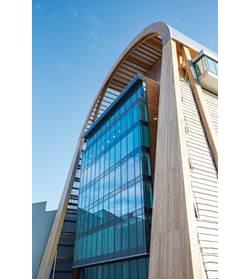Buildings have been constructed in timber since the dawn of time, but none have been quite as striking as Leeds Recycling and Energy Facility. Scheduled for completion in summer 2016, the Energy from Waste facility is a prime example of the changing face of an industry embracing innovations in construction and architecture.
Paul Gouland, Marketing Manager at Clugston Construction, explains more.Increasingly Energy from Waste (EfW) plants are moving away from the traditional ‘square box’ designs and implementing modern architecture to build eye-catching facilities, which better depict the modern hi-tech facilities they house.
A good example of this in practice is one of Clugston’s current projects, the Leeds Recycling and Energy Facility (RERF). The facility is being built by Clugston in joint venture with CNIM, the French specialist process engineers, for Veolia, who have secured a waste management contract with Leeds City Council.
Award-winning designs
The Cross Green development in Leeds features a striking 42m high-arched timber frame, an award-winning design, which will enclose the process hall. Making use of traditional materials in a non-traditional manner, it is believed to be the largest ever timber frame – measuring 123m long and 35m wide – of its type to be erected in the UK.
The arches have been manufactured using Glulam laminated timber, supplied by German timber frame specialist Hess Timber, one of the most sustainable construction materials available. The completed project will also integrate an 1800m² green wall consisting of robust plants, making it one the largest in the world.
The sustainable theme is retained throughout the construction site, which uses recycled products in its foundations. Old concrete slabs that had been covering brown field site were broken up and crushed for reuse, which saved importing new aggregate and disposing of the old concrete to landfill, in turn cutting out hundreds of wagon movements.
Alongside the key theme of constructing a sustainable building, which could house the process equipment, Veolia also wanted to ensure the new plant was futureproof. Not only will the facility make use of the latest available technology, but will also be able to constantly advance with changing technologies to increase the efficiency of recovering materials.
Environmentally friendly
With much talk of the circular economy, the new generation of EfW plants are playing their part and seeking every avenue to re-use and recycle materials it both processes and uses in their construction. It is estimated that during the 25-year Private Finance Initiative (PFI) contract the facility will help the Council meet its environmental targets saving, during the period, more than £200m in landfill tax and environmental levies.
The new plant will have the ability to divert and process approximately 214,000 tonnes of waste each year, which would otherwise have gone to landfill. About 20% of this is expected to be recyclable and the remainder will be incinerated to generate up to 11MW of reusable electricity to the National Grid – sufficient to power up to 20,000 homes. The facility will also have the potential to provide heat to local sites by capturing steam from the processes and piping it via a proposed new local distribution network.
Waste transported to the Leeds facility will pass through an automated state-of-the-art pre-treatment plant where any recyclable materials, such as cardboard, plastic, ferrous and nonferrous metals will be removed for recycling. The remaining waste will then pass by elevated conveyor into the energy recovery facility and stored within a large bunker with 26m high walls, from where it will be fed into the process hall.
The future of EfW plants
Whilst the base features of EfW plants remain relatively consistent, no two facilities are the same and each is unique. The required process capacity, site constraints and local planning can all impact on the building design and layout.
Examples of different types of sites that Clugston has worked on include the EfW facility at Ardley in Oxfordshire for Viridor. Designed to process 300,000 tonnes of residual non-recyclable waste and capable of generating 24MW of electricity, the architect designed the building to mimic one of the dinosaur footprints found in the limestone quarry where the scheme was built. The result is an eye-catching building, that can be seen from the nearby M40.
Similarly the Lincolnshire facility for FCC, which opened last year and can convert 150,000 tonnes of municipal waste into 11MW of electricity, incorporates some of the most innovative use of external cladding in the UK. As for the Leeds EfW facility, it has already become an iconic building on the South Eastern gateway into the City.
With indications that the market for larger scale municipal EfW plants is drawing to an end, the future trend will be towards finding economic solutions for the smaller municipal waste authorities and dealing with the still large volumes of commercial and industrial waste.
Original Link - FC&A
This project won the Project of the Year Award at the 2015 Structural Timber Awards.









